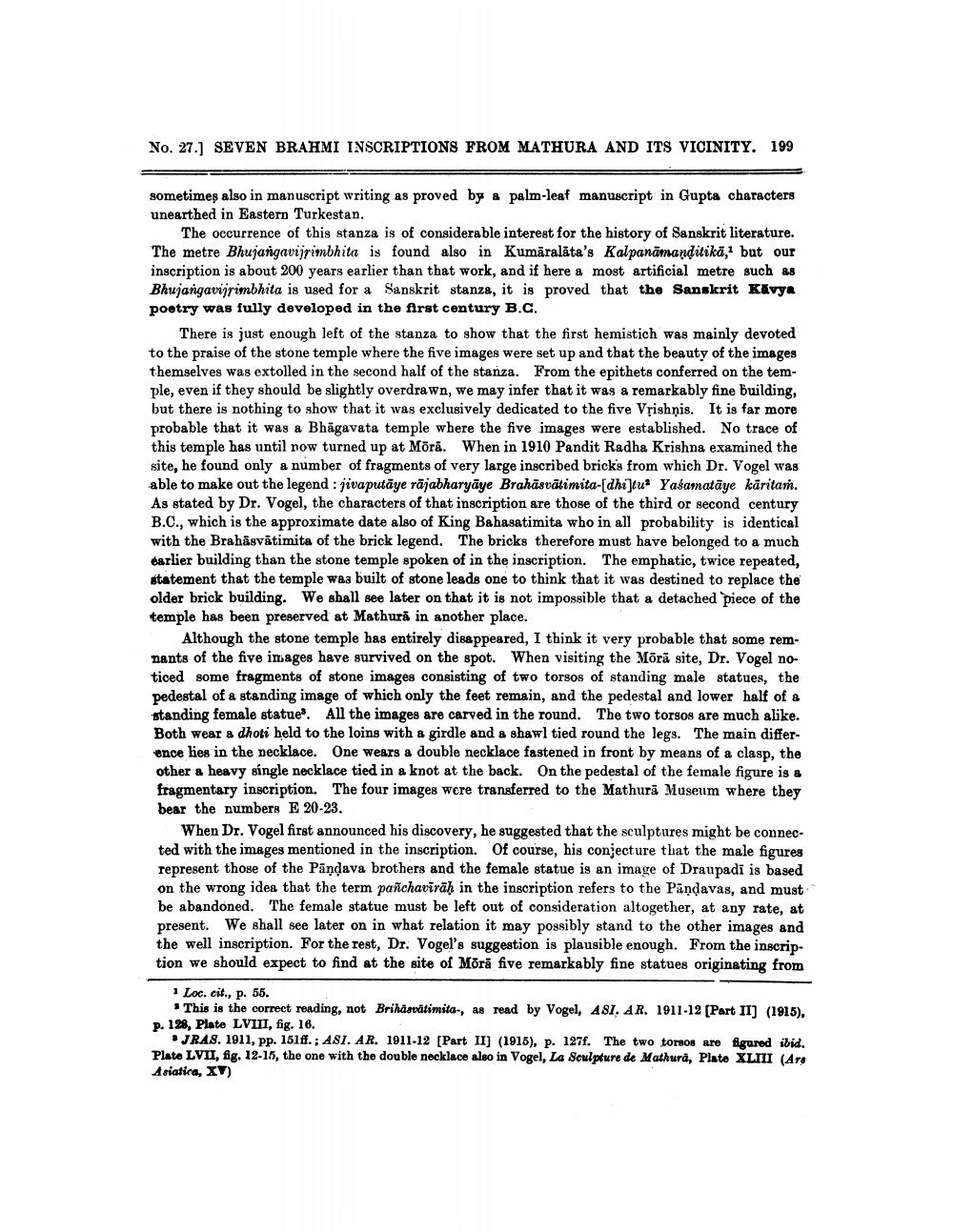________________
No. 27.] SEVEN BRAHMI INSCRIPTIONS FROM MATHURA AND ITS VICINITY. 199
sometimes also in manuscript writing as proved by a palm-leaf manuscript in Gupta characters unearthed in Eastern Turkestan.
The occurrence of this stanza is of considerable interest for the history of Sanskrit literature. The metre Bhujangavijrimbhita is found also in Kumāralata's Kalpanamanḍitikā, but our inscription is about 200 years earlier than that work, and if here a most artificial metre such as Bhujangavijrimbhita is used for a Sanskrit stanza, it is proved that the Sanskrit Kavya poetry was fully developed in the first century B.C.
There is just enough left of the stanza to show that the first hemistich was mainly devoted to the praise of the stone temple where the five images were set up and that the beauty of the images themselves was extolled in the second half of the stanza. From the epithets conferred on the temple, even if they should be slightly overdrawn, we may infer that it was a remarkably fine building, but there is nothing to show that it was exclusively dedicated to the five Vrishnis. It is far more probable that it was a Bhagavata temple where the five images were established. No trace of this temple has until now turned up at Mōra. When in 1910 Pandit Radha Krishna examined the site, he found only a number of fragments of very large inscribed bricks from which Dr. Vogel was able to make out the legend: jivaputaye rājabharyāye Brahāsvātimita-[dhi]tu Yasamataye karitaṁ. As stated by Dr. Vogel, the characters of that inscription are those of the third or second century B.C., which is the approximate date also of King Bahasatimita who in all probability is identical with the Brahasvätimita of the brick legend. The bricks therefore must have belonged to a much earlier building than the stone temple spoken of in the inscription. The emphatic, twice repeated, statement that the temple was built of stone leads one to think that it was destined to replace the older brick building. We shall see later on that it is not impossible that a detached piece of the temple has been preserved at Mathura in another place.
Although the stone temple has entirely disappeared, I think it very probable that some remnants of the five images have survived on the spot. When visiting the Mōra site, Dr. Vogel noticed some fragments of stone images consisting of two torsos of standing male statues, the pedestal of a standing image of which only the feet remain, and the pedestal and lower half of a standing female statues. All the images are carved in the round. The two torsos are much alike. Both wear a dhoti held to the loins with a girdle and a shawl tied round the legs. The main difference lies in the necklace. One wears a double necklace fastened in front by means of a clasp, the other a heavy single necklace tied in a knot at the back. On the pedestal of the female figure is a fragmentary inscription. The four images were transferred to the Mathura Museum where they bear the numbers E 20-23.
When Dr. Vogel first announced his discovery, he suggested that the sculptures might be connected with the images mentioned in the inscription. Of course, his conjecture that the male figures represent those of the Pandava brothers and the female statue is an image of Draupadi is based on the wrong idea that the term pañchavirāḥ in the inscription refers to the Pandavas, and must be abandoned. The female statue must be left out of consideration altogether, at any rate, at present. We shall see later on in what relation it may possibly stand to the other images and the well inscription. For the rest, Dr. Vogel's suggestion is plausible enough. From the inscription we should expect to find at the site of Mōrā five remarkably fine statues originating from
1 Loc. cit., p. 55.
This is the correct reading, not Brihasvätimita-, as read by Vogel, ASI. AR. 1911-12 [Part II] (1915), p. 128, Plate LVIII, fig. 16.
JRAS. 1911, pp. 151ff.; ASI. AR. 1911-12 [Part II] (1915), p. 127f. The two torsos are figured ibid. Plate LVII, fig. 12-15, the one with the double necklace also in Vogel, La Sculpture de Mathura, Plate XLIII (Ars Asiatica, XV)




